Our upcoming meeting and pizza for plants!
Lane Conville-Canney
Join us on September 11th for a wonderful GNPS member program. Our partners at Blue Heron Nature Preserve and Atlanta Audubon will share some great highlights of work they are doing with the Georgia Native Plant Society. It is really wonderful to hear from like-minded organizations who partner to educate even more people on the connections between native plants and wildlife. We hope to see you there! Social hour begins at 6:30 p.m., and the presentations begin at 7:00 p.m. Carpoolers may receive a parking voucher.
When you have delicious pizza at The Local Pizzaiolo, part of the proceeds will be donated to GNPS! On Monday, September 17, the Toco Hills location is partnering with GNPS so everyone who dines there will be eating amazing pizza and supporting GNPS. We hope to see you enjoying pizza for plants on September 17th!
Chapter News: West Georgia
Marc LaFountain
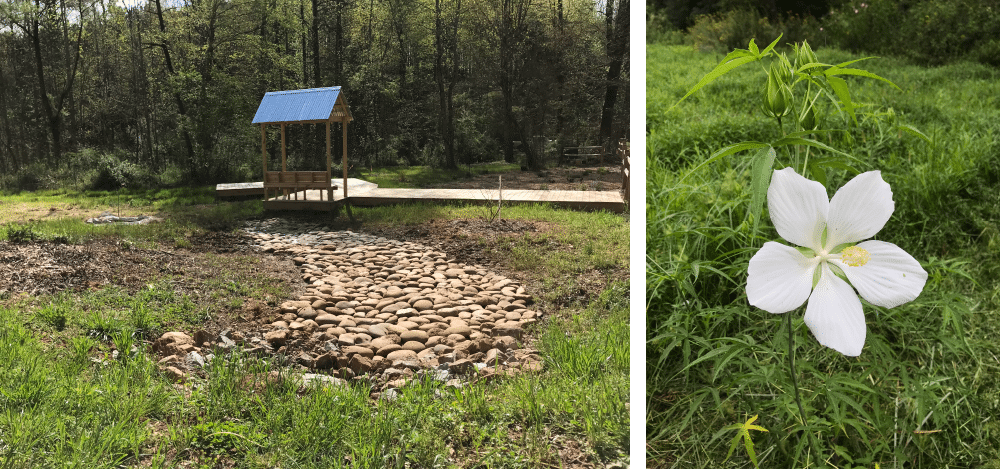
River rock recently set in mortar near boardwalk and swamp hibiscus (Hibiscus coccineus).
The West Georgia Chapter's June public program was the “Owls of Georgia,” presented by Jim Ozier, Wildlife Biologist with the Environmental and Natural Resources group of Georgia Power. The August program was “Mason Bees and Bumblebees,” presented by Becky Griffin, a Georgia Certified Beekeeper and the Community and School Garden Coordinator for the UGA Extension's Georgia Center for Urban Agriculture, Northwest District. On October 16, Robin Santos, Common Apothecary, will discuss the medicinal properties of native plants, including their history and folklore.
We will hold our annual Fall Workshop and Plant Sale on Saturday, September 15, from 8:30 a.m. to 1:00 p.m. at the Agriculural-Educational Center, 900 Newnan Rd, Carrollton. The theme will be “Wildflower Meadows” and will feature presentations by two GNPS members: Leslie Edwards, co-author of The Natural Communities of Georgia, and Walter Bland, Managing Partner, Rock Spring Restorations. Native plants will be available for sale. The meadow theme is particularly relevant for us, since we held the grand opening in April of the Meadow Entrance to our Buffalo Creek Trail, which links it to the Carrollton Green Belt. The Buffalo Creek Trail is a publicly owned 40-acre conservation site that we manage, and the Green Belt is an 18-mile walking/biking trail that circles the city of Carrollton. At the Meadow Entrance, we have installed a pollinator garden, and we are in the process of developing a rain/bog garden and a meadow.
Several of our Board members have been very active making presentations to garden groups, including our participation in two events hosted by the Carroll County Master Gardeners. One was Art in the Garden, an annual event where local artists display their creations in the Buffalo Creek Gardens, and the other was Camp Dirty Knees, where children walked the Buffalo Creek Trail, learning about native plants and planting rescued ferns.
In August we received a $1300 impact grant from Carroll EMC. These funds will allow us to complete the split-rail fence that encloses the pollinator garden and meadow area at our newly opened Meadow Entrance. They will also permit us to place additional river rock to help control erosion in the area of the meadow where the rain/bog garden is being developed.
Plant Spotlight: Helianthus, late summer standouts
Ellen Honeycutt
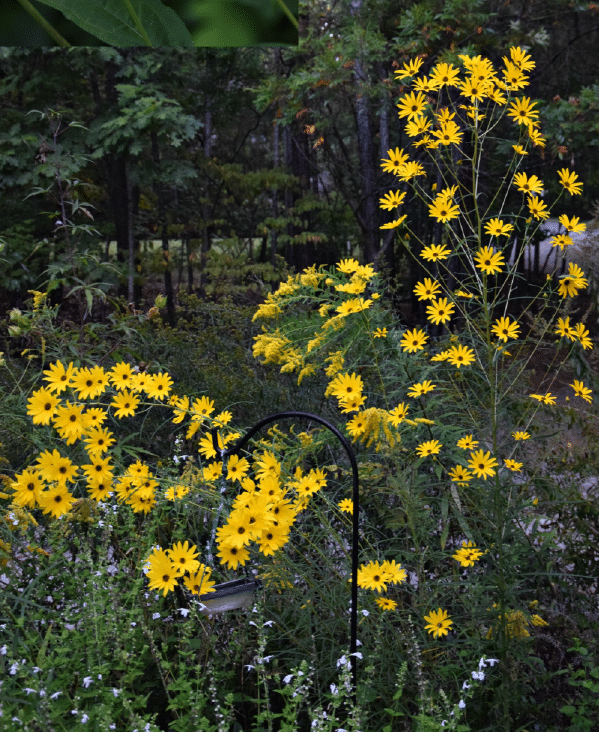
Helianthus angustifolius is ideal for a tall October garden backdrop.
Sunflowers (Helianthus sp.) are starting to shine on roadsides and in gardens throughout Georgia. This almost uniquely North American genus includes 27 species in Georgia, including species indigenous from the mountains to the coast. The genus name Helianthus comes from the Greek words helios meaning sun and anthos meaning flower. While most species are perennial, several are annual, including two very well-known ones: the common sunflower bred for show and seeds (Helianthus annuus) and the Stone Mountain daisy (Helianthus porteri).
Most of the sunflowers are perennial. On the roadsides, you might spot some of the tough, rhizomatous species like woodland, hairy, and small-headed sunflowers (Helianthus divaricatus , H. hirsutus, and H. microcephalus). They have oppositely arranged leaves with scratchy surfaces and flower heads that are a composite of tiny disk flowers (in the center) and showy ray flowers around the edge (what we think of as petals).
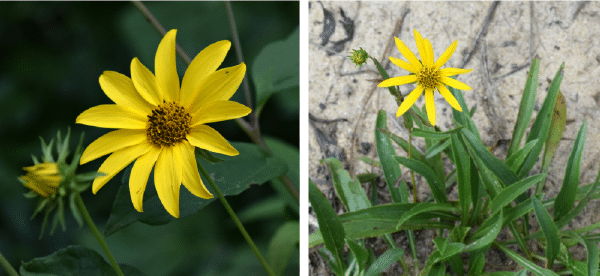
Robust Helianthus species include H. divaricatus (left), which may be found along the roadside, and H. longifolius (right), a resident of the coastal plain.
In the garden, several sunflowers have found their way into favor. Swamp sunflower (H. angustifolius and H. floridanus) are tall perennials that flower extravagantly in October. Helianthus tuberous is known as Jerusalem artichoke; it’s a tall perennial known for spreading but the roots are edible. One of my favorites is the purple-disk sunflower (H. atrorubens), one of the few species to have a dark center. Beach sunflower (H. debilis) and long-leaf (H. longifolius) are two of several species in the Coastal Plain.
Sunflowers are a good addition to the wildlife garden. Bees are probably the best pollinators of sunflowers and seed-eating birds like goldfinches love the seeds no matter which species you plant. Of course, we’ll get to enjoy the beautiful late summer blooms! Look for perennial sunflowers at plant sales coming up in the fall, including ours on September 22nd.
Restoration Focus: James E. McGuffey Nature Center Trails
Dale Senko
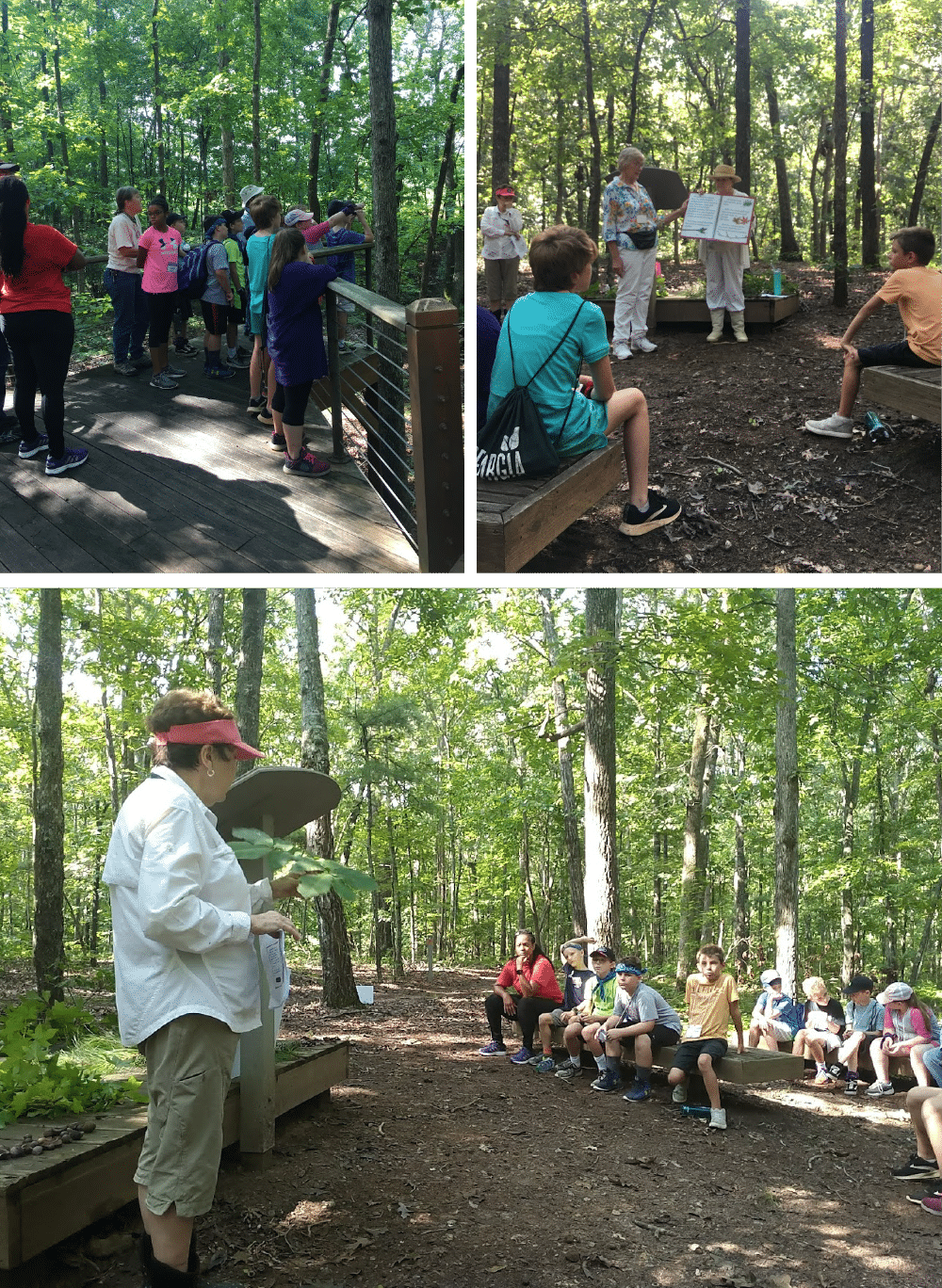
4-H Adventure Camp participants learn about nature at stops along the trail.
When we began the McGuffey Nature Center Restoration three years ago, one of our goals was to inform and educate the community. Each year we plan various events for adults and children to encourage them to visit and see the work we are doing at the site. In July we hosted the 4H Adventure Camp. We created a story trail about a squirrel who lives in the woods. The "story" led the kids to various stops along the trail to observe and identify plants and wildlife. Master Gardener volunteers led the learning activities at each location.
Located just off I- 85 South, southwest of Atlanta, the property is part of the Coweta County Fairgrounds. The Nature Center is situated at the head of a paved accessible trail and five other trails. The paved trail meanders through a woodlands area of pines and hardwoods and an overgrowth of privet and other invasive species. The unpaved trails are located on the other side of a spring fed pond and have older hardwoods and some native azaleas. Non-native shrubs and trees surround the Nature Center courtyard and entry area.
GNPS Plant of the Year 2019: Nominations on October 1
Valerie Boss

Plant of the Year 2018: Callicarpa americana.
Do you ever look at a truly wonderful native plant and think---why don’t more people grow this gem in their gardens? Here’s your chance to nominate it for GNPS Plant of the Year 2019.
Nominations will open at 7 p.m. sharp on October 1st and continue until six acceptable nominees have been submitted. (Premature submissions will not be considered, so don’t submit early). Nominations must include the common and Latin names for the species, as well a brief (or not so brief) reason why it would make a great GNPS Plant of the Year. Photos of the nominated plant are most welcome. Send nominations to PlantOfTheYear2019@gnps.org. Submissions will be confirmed upon receipt, so if you don’t get a reply in a few minutes, resend.
All acceptable nominees must be:
- native to Georgia,
- underutilized in gardens and landscapes and/or vital to the GA ecology,
- adaptable enough to grow in most gardens, and
- not a previous GNPS Plant of the Year. (Previous winners can be found on the GNPS website.)
You must be a member to nominate, so make sure your membership is up to date!
GNPS grants
Elaine Nash
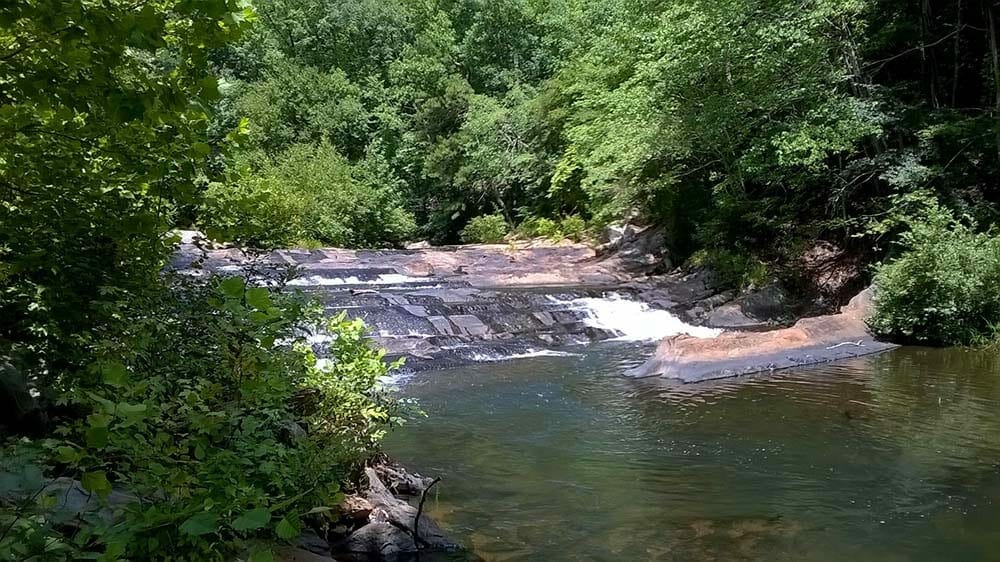
Rapids in the Snake Creek Gorge.
If you attended our March meeting, you saw one of the products of our Jeane Reeves Research Grant Program. Toby Sanders presented the results of an extensive botanical survey of the Snake Creek Gorge, located on the Brevard Fault Zone near Whitesburg, Georgia. The entire presentation is archived under "Speaker Presentations" in the Member Documents on the GNPS web site, but you have to be logged in as a member.

Indian pink (Spigelia marilandica) has strong potential as a food provider for hummingbirds in urban gardens.
Grants are an important part of the Society's role of conservation, and two more proposals were recently awarded funding. James Howard and Kim Pickens (Middle Georgia State University) were awarded a grant to find ways to increase successful germination rates of Spigelia marilandica (Indian pink) in cultivation. An important flower for hummingbirds, S. marilandica suffers from increasing loss of the natural wooded areas in which it thrives, and development of new urban-tolerant cultivars will depend on improved propagation methods.
The other funded proposal was from Heather Gladfelter (School of Forestry and Natural Resources, University of Georgia), who will be working with the plant we featured in last month's Plant Spotlight, Franklinia alatamaha. As noted in that article, genetic diversity of Franklinia is extremely limited due to the limited population that existed when it was first discovered and collected. This research will attempt to better understand just how much diversity exists among living specimens, with the hope of finding enough variation to lead to future discoveries, such as finding some resistance to a pathogen that probably was the major contributor to its extinction in the wild.
Looking for an old newsletter?
Tom Collins
Recent copies of NativeSCAPE (since the transition to an eNewsletter) are available on the web site, under "About Us": https://gnps.org/about-us/nativescape/. If you need an older one, log in to the site as a member, go to the Member Portal, and then to the Member Documents. There, you will find a folder named "Newsletters," along with other documents available only to members.
The Fall Plant Sale is almost here!
Lori Conway
If you have been meaning to volunteer for the Fall Plant sale, now is the time to fill out the Volunteer Form. We especially need volunteers for the day of the sale. Remember, the sale is from 10:00 a.m. to 2:00 p.m. on Saturday, September 22. It's important that you complete the online signup so we can accurately plan to feed all our hungry volunteers! THANK YOU!!
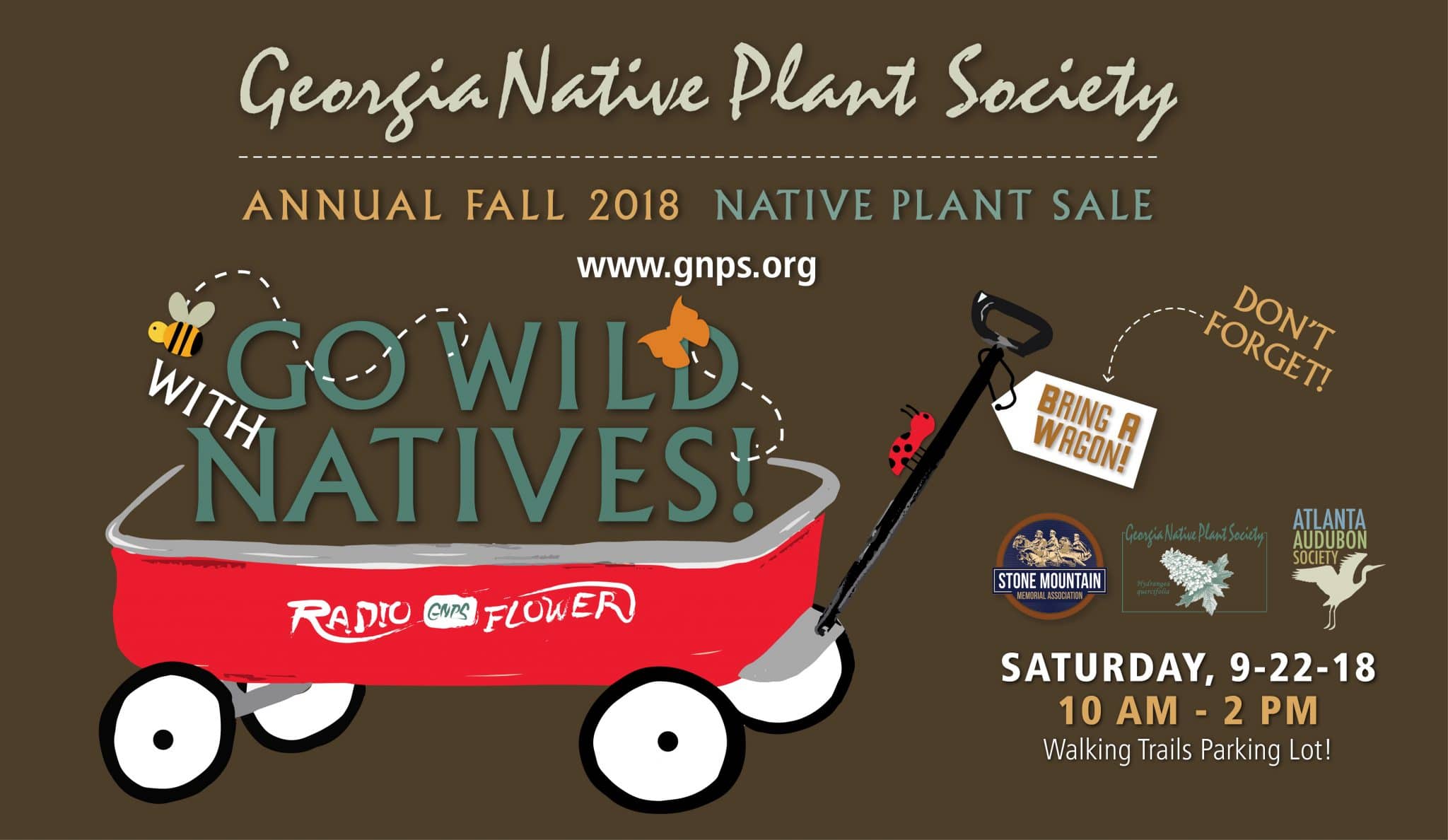
|